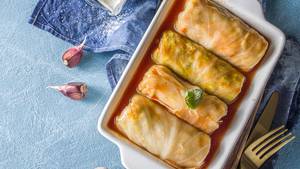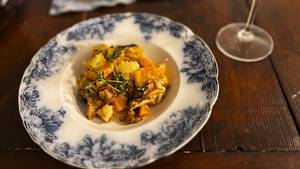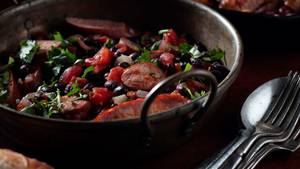There has been quite an evolution to the perception of Germany’s place on the dining table. Historic 70s and 80s pairings were rooted in classic German fare such as schnitzel, spätzle, sauerbraten, and other traditional dishes. Then riding the wave of 90s and early 2000s fusion, sommeliers sought to embrace German wines paired with Asian-inspired dishes. Those traditional and fusion-style pairings still work, but now a number of top sommeliers are simplifying, and localizing their German wine and food pairings. We asked sommeliers from coast to coast to provide their thoughts on how to pair their favourite German wine styles.
The Island Pfalz Waltz: the alluring combination of PEI Clams and Pfalz Riesling
Prince Edward Islander, and 2017 Best Sommelier of Atlantic Canada, Lesley Quinn, says “my favourite style of German wine is without doubt, Riesling. In particular, I love the dry, full-bodied styles that emerge from the warm, sunny hillsides of the Pfalz region.” As for the pairing, Quinn suggests the style is the perfect complement for one of her favourite Island (Prince Edward Island) treats, bar clams.” PEI bar clams are a staple of every touristy restaurant from Souris to West Point, where they are invariably served battered and deep fried. However, Quinn says, they are best served “straight out of the jar and served in a fresh green apple, arugula salad with a honey lime vinaigrette. If I have the time, I toast some nuts (cashews are my favourite) and add them to the mix for a bit of a crunch.” For the landlubbers, PEI clams are often harvested, then cooked and then immediately jarred. It’s an East Coast thing! To make them “Cru” style, we cooked made in the style of escabeche.
Apple, Arugula and Bar Clam Salad
2 tbsp vegetable oil
2 shallots
2 lb bar clams, soaked in peppered water for 1 hour, rinsed
¼ cup salted water
½ cup extra virgin olive oil
4 unpeeled garlic cloves
Sprig rosemary
2-3 sprigs thyme
1 bay leave
1 tsp peppercorn
Half lemon, zest
½ tsp sweet pimenton (paprika)
1/4 cup white wine vinegar
½ tsp sea salt
6 cups baby arugula
Honey lime vinaigrette*
2 green apples, cored, finely sliced acidulated
1 cup cashew, toasted
Directions: Place a large pot over medium-low heat. Add vegetable oil and shallots. Sauté until shallots are soft and translucent, about 3 to 4 minutes. Add the bar clams and water, raise heat to medium and cover pot. Steam until bar clams open (about 6 to 8 minutes). Discard any that do not open. Drain, and let cool. When clams are cool, remove meat from shells and place in a bowl. Return pot to heat and add the olive oil, garlic cloves, rosemary, thyme, bay leaf, peppercorn and lemon zest. Simmer over medium-low heat for 10 minutes. Add pimenton, vinegar and salt to pot. Pour warm liquid over the clams, cover and let cool. When cool transfer to a sterilized jar and refrigerate overnight.
Place arugula in large bowl. Add enough honey lime vinaigrette to coat leaves and toss. Season with salt. Top with green apple slices and toasted cashews. Serve accompanied with jarred clams, and let guests add to a salad as they see fit.
*Place 1 tablespoon honey, 1/2 teaspoon minced garlic, 1 teaspoon Dijon Mustard, 2 tbsp apple cider vinegar and juice and zest of 1 lime in a bowl. Whisk in 1 tablespoon extra-virgin olive oil. Whisk until emulsified.
Classic Prädikät Rieslings with Classic Québécois Fare: a simply satisfying approach
Veronique Rivest, Québec, Runner-up ASI Best Sommelier of the World 2012
Of her love of classic German Riesling, Veronique Rivest, one of Canada’s most accomplished and beloved sommeliers say “you could get talking for ages about German wines. It aways saddens me a bit, the abandonment of classic Pradikät styles (Kabinett, Spätlese, Auslese etc.). Yes, Germany is making some terroir driven dry Riesling, as is Alsace and Austria but nobody can make wines like classic German Kabinett, Spätlese and Auslese. When aged these are not only some of the best German wines I’ve tried, they some of the best aged white wines of the world, period.”
When it comes to pairing these wines, particularly Kabinett and Spätlese, Rivest says “while a lot of people will point to Asian cuisine, I point to simpler more authentic German food. In reality, there are not a lot of German Thai restaurants. That said, there is a lot of great traditional German food.” For a homegrown suggestion Rivest suggests these wines with a good pork rillette or a roast pork loin stuffed with apricots and rosemary, served over a cauliflower and pear purée. As she says, “both Québécois and Germans enjoy eating pork.”
Roast Pork with Apricots and Cauliflower Pear Purée
Ingredients (pork):
1 pork tenderloin
Salt and pepper
1/2 cup apricots, pitted diced
1 tsp fresh rosemary leaves, chopped
1 clove garlic, minced
1 lime, zest, juice
1 tbsp Dijon mustard
1 tbsp olive oil
Ingredients (cauliflower)
1 head cauliflower, florets removed
2 pears, peeled, cored, chopped
1 tsp rosemary leaves, chopped
1 clove garlic, minced
2 tbsp vegetable oil
3 tbsp heavy cream
1 tbsp butter
Salt and pepper
Directions: Cut a slit lengthwise down the centre of the tenderloin, ensuring you aren’t cutting completely through the other side. Open up and lay out on worksurface. Cover with plastic wrap and pound to ½-inch thickness. Remove plastic wrap and season inside with salt and pepper. Toss apricots with rosemary, garlic, lime zest and lime juice. Distribute along the length of the tenderloin. Roll up like a jelly roll, starting from long end, and then tie with kitchen twine. Combine Dijon mustard and olive oil and massage around the outside of the tenderloin. Place in baking dish and roast for 30 to 35 minutes at 375 F. Let rest before slicing and serve.
Toss cauliflower, pear, rosemary, garlic and vegetable oil. Place on a baking sheet and place in oven along with pork. Roast for 30 minutes. Remove from oven and transfer to a blender. Add cream and butter. Purée until smooth. Season with salt and pepper. Serve warm.
Friendly Manitoba Welcomes German Riesling: a cross Atlantic union of cultures
Felix Faundez-Rubio, Manitoba, Runner-up Best Sommelier of Manitoba 2021
“Friendly Manitoba”, adorns the license plates of Manitobans. This is reflected in the confluence of the many nationalities that have found a home on the Canadian prairies, where astounding sunsets provide the promise of a beautiful tomorrow. The variety of cultures that have come to call Winnipeg and the surrounding towns home, also brought with them their traditions of dancing and food. Of the melting pot nature of Manitoba Felix Faundez-Rubio, Runner-up at the Best Sommelier of Manitoba 2021 contest, says “two of the most identifiable cultures in Manitoba are Ukrainian and Polish. The food of both are based on a heart-warming and flavourful mixture of pork sausages, sauerkraut, dill and soft dough. These elements, present themselves across central Europe, can be found in areas where cool weathers call for comforting food and wines; areas such as Germany’s Mosel and Rheingau.”
In terms of his favourite German wines Faundez-Rubio praises “Riesling for its lively acidity which keeps its freshness when paired with dishes. German Rieslings often also have a slight touch of sweetness for contrast in the mouth. However, several regions have focused on wines that will express the graciousness of the grape in dry versions. Words that will help identify a dry German Riesling are “trocken” (literally: dry), and “Grosses Gewächs” (“Great Growth”), a classification term that always denotes a great-site wine, dry in style.”
Sitting on the Mosel River, the steep slopes of the Mosel wine region offer a variety of styles following the Prädikat scale, from bone dry to fairly sweet Rieslings. According to Faundez-Rubio “the key factor to enjoy a good bottle of Riesling is the balance of acidity that it displays, and such balance is achieved thanks to the particular conditions of the terroir of the Mosel. Vineyards on steep slopes with the best sun exposure allow the grapes to ripen properly in cold climate of the Mosel. The river itself reflects the sunlight and keeps the heat of the day to release it uphill during the cooler nights. The blue and red slate soils in the region define floral and delicate or richer and muscular wines, respectively, and add salty minerality that makes structured, sharp Rieslings.”
According to Faundez-Rubio, the structure of the wines make a great complement for the generous flavours of pierogi, kielbasa, dill pickle soup, borscht, and gołąbki / holubtsi (cabbage rolls).
“One day your heart will find a reason to take you to the flat lands of Manitoba. Either it is this experience or another reason, do not miss out enjoying some of this hearty food with an outstanding German Riesling. You will see there is nothing flat about flavours here,” concludes Faundez-Rubio.
Gołąbki (Polish Stuffed Cabbage Rolls)
1 head white cabbage
2 tbsp butter
1.7 lb ground pork
1 large onion, chopped
1 tsp finely chopped garlic
½ cup cooked rice
1 tbsp dried marjoram
1 l chicken stock
Salt, to taste
¼ tsp ground black pepper
A handful of chopped dill or parsley, to garnish (optional)
Tomato Sauce:
⅓ stick (30 g) butter
1 tbsp all-purpose flour
1 cup remaining stock
2 cups tomato purée
1 tbsp tomato concentrate
A pinch of sugar
Salt, to taste
¼ tsp ground black pepper
Directions: Bring a large pot of lightly salted water to a boil. Cook the cabbage head in water, with a cover, for 3 minutes. Remove the cabbage from the pot and let it sit until the leaves are cool enough to handle. Keep the water in the pot. Remove and set aside 15–18 whole leaves from the cabbage head, cutting out any thick parts. Chop the remainder of the cabbage and spread it in the bottom of a casserole.
Melt butter in a large skillet over medium-high heat and add chopped onion. When it turns golden, add chopped garlic and fry for another 1–2 minutes. Cool. In a large bowl, combine the ground pork, cooked rice, marjoram, and onion/garlic. Preheat oven to 350 °F (175 °C). Place about 1/2 cup of the mixture on a cabbage leaf. Roll the leaf around the mixture, tucking in the sides. Do this with 10 leaves. Place the rolls on top of the chopped cabbage in the casserole and season with salt and black pepper. Cover with a layer of remaining leaves. Gently, pour the stock in and cook on a medium heat, covered, for about 40–50 minutes until the cabbage is tender.
After the rolls are cooked, for the tomato sauce, melt the butter in a saucepan and then add in the flour. Whisk together and cook until it gains some colour. Pour in a cup of the stock used to cook the rolls. Bring to a boil, then reduce the heat. Pour in the tomato purée and add the tomato concentrate. Bring to a boil again, then reduce the heat to a minimum. Season with salt and ground pepper. If the sauce feels too acidic, add a pinch of sugar, to balance. Pour the sauce over the cabbage rolls and cover with aluminium foil. Bake in the oven for 1 hour.
Note: Polish and Ukrainian cabbage rolls are similar, and the meat in their fillings may include beef and/or pork. In holubtsi, from Ukraine, the stuffing often has potato, and they can be prepared with or without meat.
Diving Deep for a Great Pairing: BC scallops and German Silvaner
Christina Hartigan, Wine Director, Gooseneck Hospitality
Riesling may be Germany’s most prominent and perhaps prestigious grape varietal, but sommeliers are increasingly seeking out Germany’s other varietals. Case in point is Silvaner, an early ripening varietal that is most commonly associated with Franken (nearly a quarter of German Silvaner production is from here).
Silvaner comes from a natural cross between Traminer and Österreichisch Weiss (literally Austrian white) and is one of the oldest grape varieties. In 1659, the cultivation of Silvaner was first documented in Germany, namely in Castell (Franken). It was once the most important grape in Germany. Silvaner can produce moderately rich wines, with mild acidity, but can also be a great conveyor of terroir. A classic pairing to asparagus, Hartigan recommends “Silvaner, and specifically Thörle Probstey Silvaner from the Rheinhessen, matched with pan seared British Columbia scallops, topped with a lemon and chive beurre blanc, and accompanied with grilled asparagus.”
Pan San Seared Scallops with Lemon Chive Beurre Blanc and Asparagus
1 shallot, finely diced
10 tbsp butter, cold, cubed (1 tbsp cubes)
1/2 cup Silvaner
1 large lemon, juice
2 tbsp heavy cream
Salt & pepper
2 chives, finely diced
2 tbsp olive oil
12 large BC rock scallops, patted dry with paper towel
1 lb asparagus, trimmed
Lemon wedges, for garnish
Directions: Sweat shallot in 1 tablespoon of butter in pan set over medium heat for 3 minutes. Add wine and lemon juice. Raise heat to medium-high, when you have a rolling simmer, reduce to medium. When sauce has thickened add heavy cream. Lower heat to medium-low. Whisk in all but one of cubes of butter one at a time until the sauce has emulsified. Finish with pinch of salt and pepper, and chives.
Set another pan over medium-high heat. Add 1 tablespoon olive oil and remaining butter. When butter has melted and just starts bubble, season scallops generously with salt and pepper. Gently add to pan. Seared on one side for 2-3 minutes. Turn and sear for 1 more minute. Remove from pan.
While scallops are cooking, toss asparagus with remaining olive oil and pinch of salt and pepper. Set a griddle pan over medium-high heat. When pan is host add asparagus. Cook for 2 to 3 minutes, flip and cook for another 2 to 3 minutes. To serve lay spears of asparagus on a plate, top with scallops and finish with beurre blanc. Accompany with a wedge of lemon.







